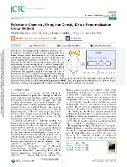| dc.contributor.author | Matoušek, Mikuláš | |
| dc.contributor.author | Vu, Nam | |
| dc.contributor.author | Govind, Niranjan | |
| dc.contributor.author | Foley, Jonathan J. | |
| dc.contributor.author | Veis, Libor | |
| dc.date.accessioned | 2025-03-03T06:14:23Z | |
| dc.date.available | 2025-03-03T06:14:23Z | |
| dc.date.issued | 2024 | |
| dc.identifier.uri | https://hdl.handle.net/20.500.14178/2985 | |
| dc.description.abstract | The emerging field of polaritonic chemistry explores the behavior of molecules under strong coupling with cavity modes. Despite recent developments in ab initio polaritonic methods for simulating polaritonic chemistry under electronic strong coupling, their capabilities are limited, especially in cases where the molecule also features strong electronic correlation. To bridge this gap, we have developed a novel method for cavity QED calculations utilizing the Density Matrix Renormalization Group (DMRG) algorithm in conjunction with the Pauli-Fierz Hamiltonian. Our approach is applied to investigate the effect of the cavity on the S(0)-S(1) transition of n-oligoacenes, with n ranging from 2 to 5, encompassing 22 fully correlated pi orbitals in the largest pentacene molecule. Our findings indicate that the influence of the cavity intensifies with larger acenes. Additionally, we demonstrate that, unlike the full determinantal representation, DMRG efficiently optimizes and eliminates excess photonic degrees of freedom, resulting in an asymptotically constant computational cost as the photonic basis increases. | en |
| dc.language.iso | en | |
| dc.relation.url | https://doi.org/10.1021/acs.jctc.4c00986 | |
| dc.rights | Creative Commons Uveďte původ 4.0 International | cs |
| dc.rights | Creative Commons Attribution 4.0 International | en |
| dc.title | Polaritonic Chemistry Using the Density Matrix Renormalization Group Method | en |
| dcterms.accessRights | openAccess | |
| dcterms.license | https://creativecommons.org/licenses/by/4.0/legalcode | |
| dc.date.updated | 2025-03-03T06:14:23Z | |
| dc.subject.keyword | light-matter | en |
| dc.subject.keyword | interactions | en |
| dc.subject.keyword | perturbation-theory | en |
| dc.subject.keyword | spectroscopy | en |
| dc.subject.keyword | molecules | en |
| dc.subject.keyword | state | en |
| dc.subject.keyword | eigenvectors | en |
| dc.subject.keyword | naphthalene | en |
| dc.subject.keyword | absorption | en |
| dc.subject.keyword | polyacenes | en |
| dc.subject.keyword | intensity | en |
| dc.identifier.eissn | 1549-9626 | |
| dc.relation.fundingReference | info:eu-repo/grantAgreement/UK/COOP/COOP | |
| dc.relation.fundingReference | info:eu-repo/grantAgreement/UK/GAUK/GAUK218222 | |
| dc.date.embargoStartDate | 2025-03-03 | |
| dc.type.obd | 73 | |
| dc.type.version | info:eu-repo/semantics/publishedVersion | |
| dc.identifier.doi | 10.1021/acs.jctc.4c00986 | |
| dc.identifier.utWos | 001340132000001 | |
| dc.identifier.eidScopus | 2-s2.0-85208594846 | |
| dc.identifier.obd | 661646 | |
| dc.identifier.pubmed | 39441199 | |
| dc.subject.rivPrimary | 10000::10300::10301 | |
| dcterms.isPartOf.name | Journal of Chemical Theory and Computation | |
| dcterms.isPartOf.issn | 1549-9618 | |
| dcterms.isPartOf.journalYear | 2024 | |
| dcterms.isPartOf.journalVolume | 20 | |
| dcterms.isPartOf.journalIssue | 21 | |
| uk.faculty.primaryId | 116 | |
| uk.faculty.primaryName | Matematicko-fyzikální fakulta | cs |
| uk.faculty.primaryName | Faculty of Mathematics and Physics | en |
| uk.department.primaryId | 1191 | |
| uk.department.primaryName | Fyzikální ústav UK | cs |
| uk.department.primaryName | Institute of Physics of Charles University | en |
| dc.description.pageRange | 9424-9434 | |
| dc.type.obdHierarchyCs | ČLÁNEK V ČASOPISU::článek v časopisu::původní článek | cs |
| dc.type.obdHierarchyEn | JOURNAL ARTICLE::journal article::original article | en |
| dc.type.obdHierarchyCode | 73::152::206 | en |
| uk.displayTitle | Polaritonic Chemistry Using the Density Matrix Renormalization Group Method | en |

